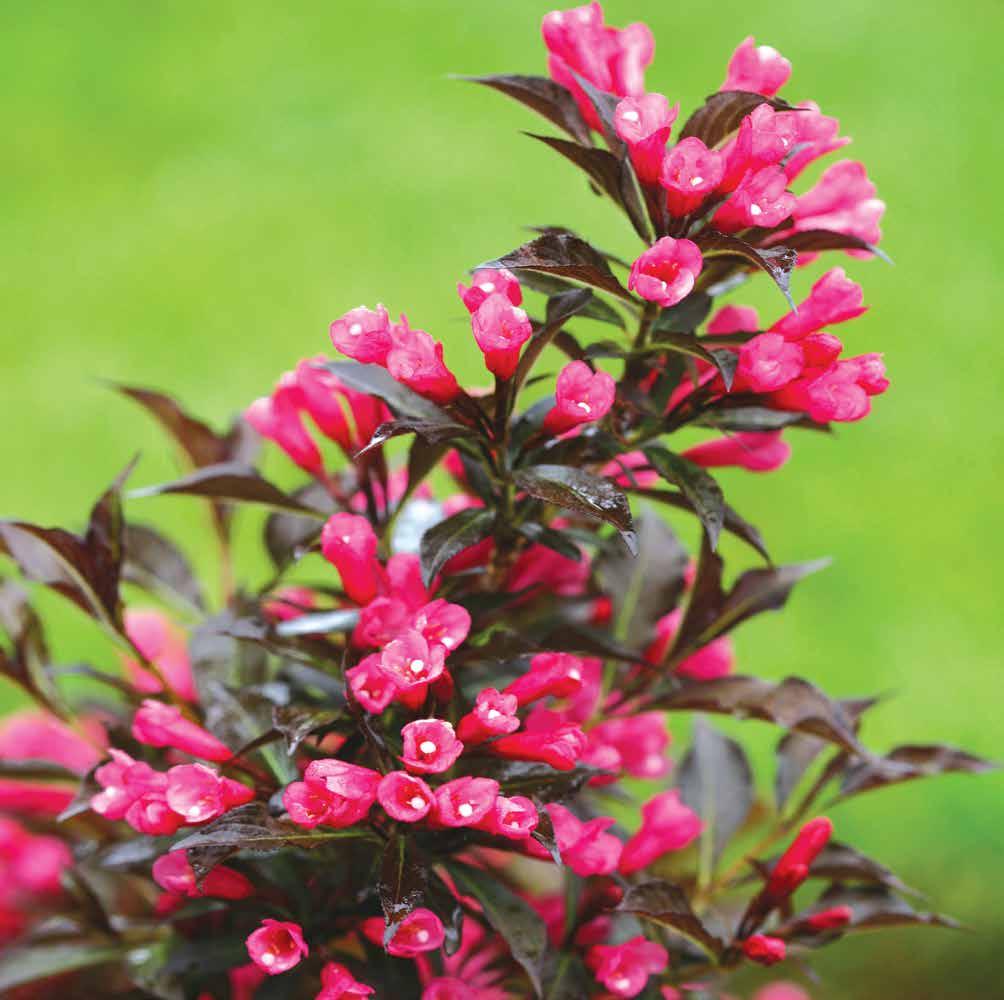
April 2023 | kcgmag.com GARDENER The Kansas City A Place for Over-Performing Plants | African Violets Rose Report | Tulip Time | Unintentional Butterfly Gardening Easy-care shrubs that will make you exclaim ‘Viva Magenta!’
Independently owned and operated since 1996
PUBLISHER
Michael Cavanaugh
EDITOR
Elizabeth Cavanaugh
CONTRIBUTORS
Natalie Carmolli
Laura Dickinson
Helen Gieselman
Lenora Larson
Jason Mispagel
Dennis Patton
Tamra Reall
Denise Sullivan
Scott Woodbury
DISTRIBUTION Publishers Delivery Solutions, Inc.

IF YOU WOULD LIKE TO DISTRIBUTE the magazine at your place of business, please contact Mike Cavanaugh at mike@kcgmag.com
913-648-4728
NEED MORE MAGAZINES? mike@kcgmag.com
913-648-4728
CONTACT US
P.O. Box 8725 Prairie Village, KS 66208
913-648-4728
ADVERTISING
Mike Cavanaugh at mike@kcgmag.com
913-648-4728
EDITORIAL
Elizabeth Cavanaugh elizabeth@kcgmag.com
913-648-4728
HOW TO SUBSCRIBE
See details on page 31.
SUBSCRIPTION
Elizabeth Cavanaugh elizabeth@kcgmag.com



913-648-4728
WEBSITE
These days as the sun rises earlier in the east, gardeners are poised and ready for the day. Wanting to make the most of daylight hours, we greet each spring day with fresh exuberance and gusto like no other season. The promise of new growth is encouragement enough for us to spend every spare moment in the garden.
For many gardening is more than creating beautiful landscapes. Gardening is a state of mind. It is a way of life. It’s supporting the local farmer’s market. It’s caring for island plantings on your street. It’s being involved in community gardens. It’s spending time on your knees weeding your neighbor’s flowerbed.
Find a new way to celebrate gardening in your life. Note the joy that it brings and the way it gladdens your heart. And then with purpose and fervor, share that joy with others. Your efforts will not go unnoticed.
Gardeners have spent many restless weeks waiting for spring’s arrival. We’ve walked through the garden looking for clues, searching for signs. Our eyes have been fixed on trees and shrubs hunting for the promise of green, and our knees are dirty from uncovering the peren-
nials that we hope will return for another season. As if on cue from a conductor’s baton, it begins ... spring breaks through.
Hidden beneath the debris we discovered the daylilies beginning their voyage towards the sun. We unveiled the salvia and coreopsis planted last year, cloaked in tender new leaves. And the weeping crabapple showed signs of breaking dormancy.
Indeed, this time of year is encouraging for all gardeners. While there’s still a chance for frost this month, the weather is a little more predictable. We count on the warming soil and spring rains to entice bulbs into bloom and budding trees to break free. Our pots and containers have made their way to porches and decks, and we’re ready to plant. We’ll make the most of daylight to start a new project or continue with the next phase of our garden plan.
With our awakening energy, we’ll call a friend and head out to our favorite nursery or garden center. Whether looking for something new or in pursuit of returning favorites, the knowledgeable staff is anxious to share what they were learning while the garden was sleeping. The benches will be full of color, and without a doubt, we’ll
not go home empty-handed. Spring brings a wave of change and renewal. The garden is anew and so are we. Our attitudes are fresh, and our hearts are hopeful. With an uplifted spirit, anything is possible. With this revival, reach out beyond your garden. Stretch beyond the garden gate and give. Give of your time, talent and treasure to something or someone new. Your reward will be undeniable.
I’ll see you in the garden!
2 April
editor’s
2023 | kcgmag.com
notes Spring
The
City
GARDENER
Kansas
kcgmag.com About the cover: Weigela Spilled Wine is an easy-care shrub with fabulous color and attractive to hummingbirds. In this issue April 2023 | kcgmag.com 4 Ask the Experts 6 Kids Ask Dr. Bug 8 Place for Over-performing Plants 10 Plants on Your Plate—Swiss Chard 12 Rose Report 14 Paola Plant Sale 16 Easy-care Shrubs 18 Unintentional Butterfly Gardening 20 African Violets 22 MDC partners with Lafite Sanctuary 23 Tulip Time 24 Indoor Gardening: Edible Mushrooms 26 Upcoming Garden Events 26 Garden Calendar 27 Subscribe 27 OPA Plant Sale
TRIALED & TESTED FOR YOUR SUCCESS















































Don’t settle for one-note azaleas; go for the total package: PERFECTO MUNDO® azaleas






















































































Proven Winners® ColorChoice® Shrubs undertook the most extensive trial in their nearly 20-year history to select only the very best from hundreds of plants to make the Perfecto Mundo reblooming azalea series as perfect as possible. It combines lush, dense habits, pest and disease resistance, and flowers with beautifully saturated colors that put on an applause-worthy repeat performance for months, rather than just weeks.









Look for Perfecto Mundo azaleas in the distinctive white Proven Winners container at your local garden center, or learn more at PerfectoMundoAzalea.com



The Kansas City Gardener | April 2023 3 SCAN TO LEARN MORE
Ask the Experts
POND SHORELINE ERODES
Question: I live along the pond in my HOA, watching as the bank slowly erodes. I am concerned about my property. How can this issue be resolved?
Answer: Dealing with water erosion is not always easy with a simple fix. I have learned Mother Nature usually wins. There are few options, and most will come with a price tag. The waves and force of the water cause the edges to cave off or erode. One option is to regrade the slope, making it gentler and more like a beach, instead of a “wall” of soil. Another option is to line the pond edge with rip rock or gabion baskets. Larger boulders of rock act as a buffer between the unstable soil and the water. Rip rock is basically an edging of rock, while the gabion baskets are blocks of rocks used to create an edge. No matter the option, a company will need access to the pond edge to place the rock or grade.
Plant materials such as native grasses may slow erosion, but the force of water will continue to undermine the soil and cause erosion.
WHEN TO PRUNE RED MAPLE

Question: I have a 10-year-old red maple. When should this tree be pruned?
Answer: Maples and several other species are often referred to as bleeders. A bleeder is a tree that tends to ooze excess sap when pruned in late winter before leaf development. Red maples pruned in late winter, as the sap starts to flow, will often drip sap from the cuts for some time after pruning.
The sap bleeding does not harm the tree, nor will it bleed itself to death. The sap is just messy and causes concern. Maples, birch, and walnuts will bleed less if pruning is delayed until after the foliage has developed. Pruning either during the dormant season or after leaf out is acceptable. Just be prepared for the potential sap flow. It will
stop, and there will be no long-term concerns with the tree’s health if a proper pruning cut is made.
IMPROVING GERMINATION
Question: I attempted to grow a vegetable transplants for the garden this winter. I had poor germination. What can I do to improve germination?
Answer: Growing your own transplants can be rewarding but frustrating. It helps me to think about growing transplants in two steps. The first is germination, and the second is the growth phase. The requirements are slightly different.
Poor germination may be related to either cool soil conditions or uneven moisture. Germination is greater and more rapid when the soil mass is kept at 70 to 75 degrees which is warmer than the growth phase. Either purchase a germination heating mat or place the tray of seeds in a warmer location. Once the seedlings start to pop through the soil, remove them from the heat source. High temperatures may cause the seedlings to stretch.
Help reduce drying out or uneven moisture by covering the seed flats with plastic to hold in humidity. Once the seeds germinate, remove the high humidity covering
to reduce disease. One last comment, light is not usually necessary for germination. When the seeds sprout, they need a high light source within three to four inches of the seedlings and left on for at least 16 hours a day or 24/7.
CONTROL HOUSEPLANT PESTS
Question: I have several house plants and have noticed little flies hovering around the plants. What they are and how to control them?
Answer: It sounds like you are describing fungus gnats which are small insects (1/8 to 1/10 inch long) common in high-organic-matter moist houseplant soils. Adults are mosquito-like in appearance. They do not bother humans or pets. The larvae or maggots of the fungus gnat can injure plants by feeding on the roots. Symptoms include sudden wilting, loss of vigor, poor growth, and yellowing leaves. The flying insects are the most noticeable symptom. Using sterile potting soil and avoiding overwatering your houseplants can help prevent infestations. Do not let water set in the saucer under the plants. Existing infestations can be controlled by Bacillus thuringiensis v. israelensis, which is sold under the names of Gnatrol and Knock-Out Gnats.
INTERNATIONAL MASTER GARDENER CONFERENCE
Question: A while back, you wrote a column on the International Master Gardener Conference. Can you tell me a little more about how I can take in some of the events?

Answer: Thanks for asking. Our Johnson County Extension Master Gardeners are hosting the conference June 18-22 at the Overland Park Convention Center. The IMGC is a professional educational improvement opportunity for master gardeners. We have over 1,000 EMGs coming from 42 states, the District of Columbia, Canada, and England. Complete conference information can be found at www. imgc2023.com.
Several activities are open to the public. The Tour of Private Gardens features six outstanding gardens and will be open for visiting on June 17 and 18. Tickets are $45 each and are good for both days. Three speaker sessions are also open. These include Sunday, June 18, Leigh Hunt, Kew Gardens, London, England, speaking about gardening in the UK. Tuesday, June 20, local author Sarah Dykman will discuss her experience of bicycling over 10,000 miles following the monarch migration. Dan Hinkley, author, plantsman, plant breeder, and landscape designer from the Seattle, Washington area, will lecture on the lost elements of good garden design. All session includes light snacks, and tickets are $49 each, or bundle all three for $109 and save. Tickets may be purchased at www.johnson.k-state.edu.
The Garden Thyme Marketplace trade show will feature over 70 garden-related vendors. Admission is free. Hours are Monday, June 19, from Noon to 7 p.m., and Tuesday and Wednesday, June 20 and 21, from 10 a.m. to 7 p.m. The trade show will be held at the Overland Park Convention Center. We hope you’ll join us.
4 April 2023 | kcgmag.com
DENNIS PATTON Horticulture Agent
Dennis Patton is the horticulture agent for Johnson County K-State Research and Extension. For free information fact sheets, visit www.johnson.ksu.edu, or call the Extension office at 913-715-7000.
Red Sunset Maple in fall.




Kids Ask Dr. Bug about the curious things found in the garden
What can I do to help the bees?

Three things: plant flowers, leave some bare soil, and don’t use pesticides. Bees need flowers for their nectar, pollen, and their stems. The nectar is like an energy drink – it has sugar and gives the bees energy. The pollen is more like a protein bar – supplying protein and nutrients. If the flowers have pithy or hollow stems, they can offer a place for many kinds of bees who lay their eggs in the stems. It’s a good idea to leave the stems in place through the winter and early spring so the baby bees can finish developing.
For the bees who prefer to make their nests in the ground, leave some bare soil – not covered by rock or bark mulch. When the leaves fall in autumn, let the leaves cover the ground to protect overwintering bees.
Be very careful with pesticides – they kill insects, including bees. Most insects are good! If you do have pest insects in the garden, there are a lot of things you can do to manage the pests while letting the good insects live. Some examples include hand-picking pests and dropping them in a container with soapy water, using plants that are resistant to diseases and pests, and following the label instructions if you need to apply a pesticide starting with the least toxic method that gives effective results. These are part of Integrated Pest Management, also known as IPM.
Some great plants with beefriendly flowers are serviceberry trees, crabapple trees, cone flowers, asters, sunflowers, bee balm, Joe Pye weed, basil, lavender, chives, borage, and zinnia.
How can the idea of IPM be shared with more people?
You can help! First, people need to know what IPM is and why it is important. Integrated Pest Man-

agement (IPM) uses science and a variety of techniques to manage pest insects and create a healthier environment for all living organisms (except the pests). IPM strategies include monitoring; identifying the suspected pest (often it is beneficial!); evaluating if the insect is causing damage, and if it is causing damage, if you need to act; preventing problems before they occur, such as by using resis-
scan the QR code to see and share the poster.

What is the normal number of eggs for insects to lay?
Each insect species has its own typical number of eggs that females will lay in their lifetime, but there is not a “normal” number of eggs for insects overall. The Australian ghost moth has been reported to lay 29,100 eggs. On the other extreme,
prefer to keep their tails, lizards have evolved to be able to break their main body away from their tails if needed. The tail is helpful for balance and impressing a mate, the rest of the lizard (head, organs in the body, and legs) is necessary to survive. When the tail detaches, it wiggles for a while which is confusing for the predator and can even provide enough of a meal so that the predator doesn’t need to keep searching for the rest of the lizard. So, while it is stressful and painful to lose its tail, at least it survived. Many lizards can regrow their tail, although it may not be a big and impressive as the original tail. NOTE: even though detaching their tail is a neat trick, please do not purposely cause lizards to do this.
Why are there so many fungi and bacteria species that we don’t know about?
tant plants, rotating crops, and using good sanitation practices; taking action when needed using the least toxic method that gives you effective results; and finally, keep inspecting for potential problems.
Advantages of using IPM strategies include healthier plants, lower costs, reduced threats to the environment and people, and you’ll get to see more beneficial insects in the garden!
To help get the word out about what IPM is and what it is about, the Entomological Society of America created a poster that gives steps and examples about how to use this method. This poster is also easy to share with others. Click here (https://bit.ly/ESA-IPM) or
some large dung beetles only lay 2-5 eggs. For the species that lay many eggs, many do not typically survive to adulthood. The insect species that lay fewer eggs invest a lot into each egg and where it is laid so that each egg has a better chance of survival. Some insects don’t lay eggs at all! Rather, some insects are born alive like you were born! Unlike the years it took for you to learn how to walk and feed yourself, these insects take care of themselves right away. An example of insects born alive is aphids. Interestingly, female aphids can even be pregnant when they are born!
Why do lizards lose their tails?
While I’m sure lizards would
Many fungi and bacteria species are very small, and many related species look very much alike. This can make them hard to tell apart. In fact, we don’t have a very good definition of what the word “species” is for some groups of fungi and bacteria because they do not fit the same species definition of other organisms. More research is needed to learn about all the different species on this amazing planet we call home. We will also need more scientists and new ways of looking at life, behavior, and habitats to make these discoveries. Maybe you’ll be one of these scientists!
Do you have questions for Dr. Bug? Send them to ReallT@Missouri.edu or https://bit.ly/KidsAskDrBug Please include your name and age. To help me learn what you learn from this column, consider filling out this survey: https://bit.ly/KidsAskDrBugSurvey
6 April 2023 | kcgmag.com
TAMRA REALL Horticulture Specialist
Dr. Tamra Reall (@MUExtBugN Garden) is the horticulture specialist for MU Extension in Jackson County. For free, research-based gardening tips, call 816-833-TREE (8733), email mggkc.hotline@gmail.com, or visit www.extension2.missouri.edu.
Bee on flowering tree




























Somewhere, a Place for Over-performing Plants
You know the song from West Side Story, “Somewhere (There’s a Place for Us)”? That tune invaded my thoughts recently (and wouldn’t go away) as I was having a conversation with a homeowner. I asked, how do you feel about river oats and wild strawberry? Is there a place somewhere in the garden for them? I asked because these are
den for almost all plants, even for plants that never played well in the sandbox with others, like ostrich fern.

Last week a colleague was fretting over ostrich fern (Matteuccia struthiopterus), because it was spreading beyond its confines in a moist woodland where it was planted. It has a sneaky way of spreading its tentacles (long underground
(Equisetum hyemale). Ted Spaid, at SWT Design in St. Louis, incorporated this ancient, rampant, evergreen fern ally with redbuds, in the parking lot islands, at The College School in Webster Groves. Good choice mate, because this plant survived the dinosaurs, and the asteroid that killed them. That’s probably why they’re surviving so well in the baking-hot parking lot.

mallow. They are all equally aggressive, sun-loving plants that fill space quickly and persist longterm.
Finally, there is wild strawberry (Fragaria virginiana), which sometimes is referred to as a green or living mulch plant. Mervin Wallace, owner of Missouri Wildflowers Nursery, has been promoting this one as a filler plant between
useful native plants, especially in naturalistic woodland and prairie gardens. But people shy away from them because they move around, and they can spread.


It’s plants like these that keep some horticulturists up at night and gives others a reason to label native plants as weeds. Sure, some native plants grow more quickly and overtake other plants, but aggressive plants exist across the entire northern hemisphere. But not all native plants move around; most of them don’t. That’s why I’m confused by native plant nay-sayers. Remember the saying—“right plant-right place.” There is a place in the gar-
roots called rhizomes) far and wide until it finds a gap in which to pop up. In my colleague’s situation, it is happily colonizing the woods along a creek. There are other plants that spread and combine well with ostrich fern. For example, palm, hop, bur, and ravens-foot sedges are beautiful mixed with ostrich fern in woodlands. So are American beakgrain, river oats, Virginia knotweed, wild geranium, Jacob’s ladder, Virginia bluebells, celandine poppy, and golden groundsel. I like to mix them to create a naturalistic planting, vibrant with color and texture variation.
Another one of my favorite aggressive plants is horsetail,
SCOTT WOODBURY Horticulturist

What’s more, they are confined to a limited space, like a robot vacuum cleaner, filling in the bed so densely that weeds can’t get a foothold. Considering it’s a school full of children, and children love dinosaurs, and most (or all) schools aren’t staffed up for pulling weeds, it’s a stroke of genius.
There is a place for plants that sucker and spread in sunny areas too. Common milkweed (Asclepias syriaca) gets a bad rap because it moves around by rhizomes and seed. But I come across all sorts of situations that need plants like this. I recently consulted on a difficultto-mow slope above a retaining wall. My recommendation included common milkweed, switchgrass, sweet coneflower, curlytop ironweed, New England aster, and, to drape over the wall, purple poppy
perennials and grasses in gardens. That’s also how it grows in a wild prairie. I can attest to its success, but I recommend that you install it a couple of years after an initial planting of desired plants. It is aggressive and may out-compete newly planted purple coneflower, wild indigo, Culver’s root, prairie coreopsis, rose turtlehead, butterfly milkweed, and others. Try it instead of applying wood or leaf mulch every year.
This reminds me of a favorite bumper sticker, given to me by the legendary Arkansas plantsman Larry Lowman. It reads “Minds are like parachutes, they only function when open.” There are many native plants, plant combinations, and planting situations yet to be discovered, so don’t take my word for it— let’s get tinkering, ya’ll.
Scott Woodbury was the horticulturist at Shaw Nature Reserve for 30 years and stepped down from that position in June 2022. He continues to work on contract for Shaw Nature Reserve to carry out native landscaping education and has launched his own business called Cacalia: Native Garden Design and Wilding. Find suppliers of native plants, seeds, and services at the Grow Native! Resource Guide: www.moprairie.org.
8 April 2023 | kcgmag.com
Horsetail and Redbud
Sweet coneflower and Switchgrass
Ostrich fern
Photos by Scott Woodbury.
1601 NE Tudor Rd, Lee’s Summit, MO (816) 525-4226

Annuals, Vegetable Plants, Herbs, Lawn Fertilizers and more.





Special on ferti-lome 5-Step Lawn Care Program Shrubs and Trees arriving daily!




Missouri Wildflowers Nursery

573-496-3492, fax: 573-496-3003 www.mowildflowers.net mowldflrs@socket.net 9814 Pleasant Hill Rd Jefferson City MO 65109
Missouri Prairie Foundation Native Plant Sale at Anita B. Gorman Conservation Discovery Center, 4750 Troost Ave, Kansas City MO 64110.
Saturday, April 15, 10 a.m. to 2 p.m.
Deep Roots Native Plant Sale at Metropolitan Community College, Longview 500 SW Longview Rd, Lee’s Summit 64081. April 22, 10 a.m. to 2 p.m. deeprootskc.org
Native Plant Sale by Burroughs Audubon at 6212 NW Barry Rd. KC MO 64154. Backyard Bird Center 816-746-1113. Saturday, April 22, 10 a.m. to 2 p.m.


Shawnee Indian Mission Foundation - Native Plant Sale at 3403 W. 53rd St, Fairway KS 66205. Saturday, April 29, 9 a.m. to 2 p.m. shawneeindianmission.org
Missouri Prairie Foundation Native Plant Sale at Anita B. Gorman Conservation Discovery Center, 4750 Troost Ave, Kansas City MO 64110.
Saturday, May 13, 10 a.m. to 2 p.m.
The Kansas City Gardener | April 2023 9 www.arnoldsgreenhouse.com info@arnoldsgreenhouse.com (620) 964-2463 • 1430 Hwy 58, LeRoy, KS 66857 Open for the season! Hours • 9am-5pm Mon-Sat Sun 1-6pm Review our plant list and plan for spring planting! Follow us on Facebook! #NeedMoreFlowers Bringing glorious living color to your garden since 1977. 6979 WEST 75TH STREET OVERLAND PARK, KS HOURS: MON-SAT 10A-5P | CLOSED SUN 913•341•0700 WildBirdHouseStore.com Find us on Facebook! LARGEST SELECTION of wild bird supplies in the KC area, including bird seed, feeders, houses and hardware. 816•924•4924 4480 SOUTH NOLAND RD INDEPENDENCE, MO HOURS: MON-SAT 10A-5P | CLOSED SUN Family-owned & operated since 1990.
Meet us at one of these locations in the KC area.
your
by Tuesday
sale, and we’ll
to
location.
Send
order
before a
bring it
the
PLANTS ON YOUR PLATE Swiss Chard
ber. The mild, sweet, earthy taste with a touch of bitterness provides a unique flavor profile. The bitterness is reduced with cooking and can be complemented with herbs or a splash of balsamic vinegar at
the end of cooking. Younger, more tender leaves are less bitter and can be blended into salad greens for a contrast in both flavor and texture. Both the leaf and the rib are utilized in this delicious summer frittata.
Swiss Chard and Squash Frittata
MAKES 4 SERVINGS
INGREDIENTS
1 lb. rainbow chard
1 summer squash, thinly sliced
4 garlic cloves, minced
1 cup chopped onions
2 tsp. olive oil
5 eggs
3 Tbs. chopped fresh basil (optional)
1/4 tsp. Salt
Swiss chard is another leafy green that sometimes gets overlooked in the produce section or farmer’s markets. Chard is actually a member of the beet family (Beta vulgaris) that does not produce a root. The leaves are similar to beet greens, but have more crinkly, ribbed sections, more closely resembling kale. The center rib of the plant can have a range of colors from white to red depending on the variety. White stalks are commonly known as ‘silver chard,’ red varieties are commonly called ‘rhubarb chard,’ while ‘rainbow chard’ can have red, yellow, orange, or pale green center ribs.
Chard is believed to have originated in the Mediterranean region near Sicily and was a popular food even before the days of the Roman Empire. It eventually grew in popularity across Europe, and was once grown in the south of France, where the center rib alone was enjoyed as a highlight of the Christmas Eve meal. Until the 1850s, Swiss chard was considered a specialty plant produced mainly for European markets. After the Civil War, the
United States began increasing production of the crop.
Most commercially grown chard comes from California, Arizona, Florida, Texas, Louisiana, and Hawaii. Swiss chard is a biennial plant but is typically cultivated as an annual and can be easily grown in the mid-west in early spring and early fall. It prefers cool temperatures as high temperatures slow down leaf production. Chard tolerates heat better than spinach does and rarely bolts like spinach is prone to do. Chard grows best in full sun, although it tolerates partial shade and likes fertile, well-worked soil with good drainage. It can even be grown as an ornamental within flower beds or pots, which I have done.
Chard is a unique green because both the leaf and the colorful stalk can be cooked and enjoyed, unlike kale, where the tough center rib is usually discarded prior to preparation and consumption. The bright colors of Swiss chard bring a variety of nutritional benefits, including vitamins A, C, and K in addition to minerals, phytonutrients, and fi-
DENISE SULLIVAN Nutrition Ninja

1/2 tsp. Ground black pepper grated Parmesan cheese (optional)
DIRECTIONS
• Wash hands and work surfaces with warm soapy water.
• Wash chard and squash in running water and drain.
• Separate the chard leaves from the rib; slice the rib thinly and roll the leaves together and slice into ribbons.

• In a 10-inch cast iron skillet, sauté the garlic, summer squash, chard ribs, and onions in 1 teaspoon of oil for 3 minutes on medium heat. Add the chard leaves, stir, cover, lower the heat, and cook for about 10 minutes.
• Remove the skillet from the heat and drain any liquid.
• In a large bowl, beat the eggs, basil, salt, and pepper until blended. Stir in the sauteed vegetables.
• Coat the bottom of the skillet with the remaining teaspoon of oil and return it to medium heat. When the skillet is hot, pour in the egg mixture. Cook without stirring for 5 to 8 minutes, until the edges are firm and beginning to brown. Place skillet in a preheated 400-degree oven and cook for 5-10 minutes, until the eggs are fully cooked and set.
• Remove from oven and cover with foil and rest for five minutes. Serve immediately, topped with grated Parmesan if desired.
NUTRITION INFORMATION
Calories: 180, Total Fat: 10g, Saturated Fat: 2.5g, Sodium: 480mg, Carbohydrates: 13.5g, Fiber:3.5g, Protein: 11g
Recipe adapted from Tufts University, analyzed by verywellfit.com.
Denise Sullivan (@MUExtJacksonCo) is a Nutrition and Health Education Specialist for MU Extension in the Urban West Region, serving Jackson and Platte Counties. For research based nutrition and food safety information and programs, call 816-482-5850 or visit https://extension2.missouri.edu/.
10 April 2023 | kcgmag.com

















The Kansas City Gardener | April 2023 11 Achillea
Asparagus Mary Washington Chrysanthemum Mammoth Lavender Coreopsis
Leucanthemum
Lily Asiatic Matrix
Nepeta
Salvia
Matter Sedum
Doozie Sempervivum Commander
Discover the Best New Perennials at a great price! Look for the 4” purple pots at these locations: Available early to mid-April in most locations. - Larry’s Nursery - Westlake ACE Hardware - Suburban Lawn and Garden - Soil Service - Grass Pad Herb Mint Mojito - Water’s, Euston, and Pack’s Hardware Stores Edible Varieties: + Other Local, Independent Garden Centers 10 colors! Large
Sassy Summer Taffy
UpTick Red
Carpet Angel
Red
Kitten Around Rose, Miniature Parade Petula
Dark
What A
Hay Veronica Skyward Pink
Spring is here at last! I love April. It is my birth month, and I feel as if I am reborn every April just like the plants in my garden. April 15—tax day—has been the traditional date to “wake up” the roses in Kansas City. But, it seems our spring weather is arriving earlier every year, and I believe it is better to listen to the plants than the calendar. So, when new leaves are unfurling, the roses are telling you they are ready, usually sometime in early to mid-April. There is a lot to do in the rose garden in April, so let’s get started on the to-do list.
Pull Back the Winter Blankets
If you piled mulch, leaves, or soil around the crown of your roses to protect them over winter, now is the time to carefully remove it. Mulch or other organic plant material can be gently raked back to expose the crown and provide open space for air flow. You may need to reach cautiously into the center of the bush to poke mulch out with your fingers. Long sleeves and heavy gloves are recommended! If you used soil to cover the crowns, gently wash it away with a hose.

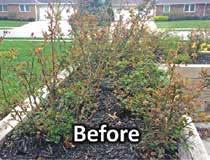
Time to Prune
Pruning can be complicated because best practices vary with the type of roses in your garden. For details on pruning specific types of roses, as well as good “before and after” photos, visit our website www.kansascityrosesociety.org and click on Rose Info, then Pruning Roses. But, if you want to keep it simple, here are the basics of rose pruning for the main types of roses in most home gardens.
Modern roses that bloom all summer include most of the popular rose varieties such as hybrid teas, grandifloras, floribundas, miniatures, minifloras and shrubs. First, cut the entire bush down by
Rose Report
Spring is calling to ‘wake up’
half. This allows you to see what you are doing and more easily make detailed pruning cuts later. Second, remove any canes that are dead (no, they will not recover if you give them time), damaged or have purple or black disease patches. Third, look for canes that are crossing and rubbing on each other. Keep the one growing in the direction that
able to see light shining through. Find a bud or emerging leaf cluster that is pointing outwards, away from the center of the bush, and prune about ¼ inch above it. This will cause the cane to continue to grow outward. The overall shape should be like a vase, with canes growing gracefully around an open center space.
main canes are called laterals, and these are what you prune. Prune the laterals down to two or three sets of buds. See photo of climber anatomy.
Old Garden roses, also called Heirloom roses, that only bloom once in early summer should not be pruned until after they have bloomed. Then you can follow the same directions as modern roses above.
Rugosa roses have a dense growth habit shaped like a cascading fountain. They do not need annual pruning, because this would destroy their natural form. Just remove any dead or damaged canes, and perhaps a few of the oldest woody canes that aren’t producing many flowers.
Time for Fertilizer
Roses are one of the few flowering shrubs that bloom continuously from May to October. This requires a lot of energy, so roses need more feeding than most landscape plants. The spring treatment is the most important to get the plants off to a good start. For details on fertilizing roses visit the Rose Info section of our website and click on Fertilizing Roses.
Optional Fungicide Treatment

If you have roses that are prone to blackspot or other fungal diseases, apply your first fungicide treatment now and continue through the growing season as your plants require.
blends best into the overall shape of the bush and cut off the other one. Fourth, prune individual canes with an eye toward the desired shape of the whole bush. Remove old, woody canes that don’t produce many flowers. Remove some canes growing in the center of the bush to improve air flow. You should be
Climbing roses need a different pruning technique. Train the long canes that emerge from the crown of the plant on a trellis or other support so that you create a fan shape. Try to angle the canes so that they are as horizontal as possible so they will produce more flowers. The side shoots that grow off these

Get ready for the show!
The hard work of April will bring the beauty and wonder of that amazing first flush of rose blossoms by the end of May. If you have any question about your roses, please contact our Consulting Rosarians at the Ask a Rosarian email helpline kcrosehelp@gmail.com.
12 April 2023 | kcgmag.com
LAURA DICKINSON Consulting Rosarian
Laura Dickinson is an American Rose Society Consulting Rosarian and is Vice-President of the Kansas City Rose Society. Laura is retired from a career in science education and program management. She can be reached at the Ask a Rosarian hotline, kcrosehelp@ gmail.com.
Photos by Glenn Hodges.








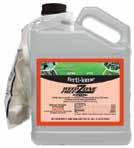


The Kansas City Gardener | April 2023 13 NOW AVAILABLE AT: Jacksons Greenhouse & Garden Center, Topeka v Doctors At the Lake, Lake of the Ozarks v Manns Lawn & Landscape, St. Joe v Gronis Hardware and Seed, Leavenworth v Clinton Parkway Nursery, Lawrence v Barnes Greenhouses, Trenton, MO v Soil Service Gdn. Center, Kansas City, MO v Loma Vista North, Kansas City, MO v Skinner Garden Store, Topeka v Full Features Nursery, Smithville v Springtime Garden Center, Lee’s Summit v Heartland Nursery, Kansas City, MO v Planter’s Seed, Kansas City, MO v Penrod’s Greenhouse, Kearney v North Star Garden Center, Liberty v Grimm’s Gardens, Atchison v Moffet Nursery, St. Joe v Suburban Lawn & Garden, Kansas City, MO Rid Your Lawn OF WEEDS with ferti•lome RAPID WEED CONTROL Works in as little as 24 hours. Dries in 3 hours & is reseedable in 3 weeks. Great for harder to kill weeds like henbit, clover, thistle, dandelions, wild violet & many more.This is the BEST weed killer available and IT WON’T DAMAGE YOUR LAWN! www.fertilome.com WEED FREE ZONE New size! 1 gal. ready to use BFG is the Leader in Green Industry Distribution
Master Gardeners’ Plant Sale in Paola Save the last weekend in April!
Marais des Cygnes Extension Master Gardeners will conduct their annual Plant Sale at the Paola Extension Office April 27, 28, 29. As always, our locally grown plants are raised without the use of pesticides so they are safe for pollinators and humans. Greg Beverlin will be onsite selling his hand-made hypertufa containers and stepping stones. Credit Cards welcome!
We also offer gardening information. Our “Lucy Booth” will be staffed with our Extension Master Gardeners, ready to answer your questions with expertise ranging from flowers to vegetable growing to butterfly gardening. We will be giving away “Seeds for Kids” and encouraging children to grow seeds and enter their flowers in our County Fair to win ribbons. A new feature: we will give away FREE used gardening books for as long as the supply lasts.
Butterflies
We are famous for our selection of butterfly host plants. Everyone wants more butterflies in their gardens and since you choose which butterflies grace your garden by which caterpillar host plants you offer, we will sell at least 40 species of host plants, including 8 species of Milkweeds for the Monarch caterpillars. Pollinators such as butterflies, honey bees, most native bees and syrphid flies are generalists, not picky about their flower choices. For them, we will have a wide assortment of nectar-rich ornamental, native and nativar perennials, as well as colorful annuals.
Native Plants
For native plant lovers, human and insect, we will feature both native species and nativars. This includes shade-loving native perennials such as Celandine (Wood Poppy), Indian Pink (Spigelia) and Black Cohosh. Whether your interest is prairie restoration or native plants grown in ornamental gardens, we will also offer a wide selection of midwestern prairie species and varieties. Since about 30%
of our native bees require a specific genus or species, we will have a wide diversity of sun-loving native flowering annual and perennial plants, which will optimize your pollinator garden’s impact.

Edibles
An abundance of both medicinal and culinary herbs will be offered, including five flavors of Basil and seven varieties of Thyme. Available varieties of fruit trees include varieties of Apple, Cherry, Peach and Pear plus Elderberry bushes and Grape vines. Berry bushes include Blueberries, Blackberries and Raspberries. For the vegetable gardener we will have carefully selected varieties of vegetable transplants, especially favorite varieties of tomatoes and peppers. For busy home gardeners with limited space, we will again offer patio pots of cherry tomatoes.
Other Plant Offerings
But we have so much more!
Traditional favorites include Clematis, Daylilies, Geraniums, Hosta, Heuchera and Peonies. In addition to the usual selections of native and ornamental perennials, we will feature succulents and hanging baskets
of annual flowers and shade-loving tropicals. Other shade-loving selections include ferns and woodland flowers. Tropical plants return, perfect as houseplants or for an exotic touch to your garden. If you are landscaping your yard, we will have a selection of native trees and ornamental grasses.

Convenient Location and Times
The sale is in the parking lot at the K-State Extension Office, 913 N Pearl (Old KC Road), Paola, KS. Rain or shine—as we proved during last year’s monsoon! The sale will open promptly at 9 am, no pre-sales. On Thursday April 27, we will be open until 5 pm. On Friday, April 28, we’ll stay open until 6 pm and close at 1 pm on Saturday, April 29. Pay by cash, check or credit card. For more information go to www.maraisdescygnes. ksu.edu. or follow us on Facebook at www.facebook.com/mdcemg or call the office: 913-294-4306.
14 April 2023 | kcgmag.com
Above: Several species of Sedum will be offered. Pollinators love their nectar and pollen!
Below: We will again carry the sensational Candlestick and Popcorn Sennas.


















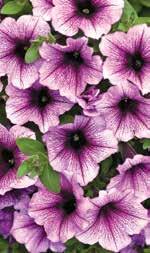
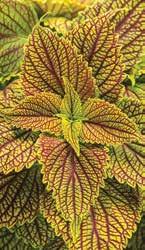




The Kansas City Gardener | April 2023 15 A Gardener’s Destination Great selection of bulk seed • Renee’s Garden, Botanical Interests • Fertilome fertilizers Beautiful spring flowering trees and shrubs Proven Winners annuals and shrubs! Planters • Urns • Garden Accents • Bird Baths Tables and Benches • Fountains 112 E. Green St. • Clinton, MO 64735 660-885-3441 • Mon.-Fri. 8-6, Sat. 8-4 125 varieties of Clematis Top Soil • Mulch • River Rock • Sand • Gravel Fireplace Materials • New & Used Brick • Pavers 9108 W. 57th Merriam, KS 66203 (1 blk E. of Merriam Dr.) Hrs: Mon.–Fri. 7am–4:30pm • Sat. 8am–12pm 913-432-8092 Mowing • Trimming Planting • Mulching Seeding • Aeration Fertilization • Clean Up Barclay Berberian 913-208-5941 LawnsByBarclay.com Design/Build • LED Lighting Pond Cleaning Services • Maintenence Repair - Leak Diagnosis • Winterization 816-560-0816 LoyalPond.com LoyalPond@gmail.com Our passion is water and providing an enjoyable outdoor oasis for our customers. GROW HAPPY PLANTS USE A CHUNKY MIX EXTRA AERATION • FAST DRAINING PEAT MOSS FREE View our products at solsoils.com. Ask for them at your local garden center. Use KCG20 for 20% off For Home and Garden... Euston Hardware 6955 Tomahawk Rd Prairie Village, KS 66208 (913) 262-1405 Euston Hardware 453 E Red Bridge Rd Kansas City, MO 64131 (816) 216-7197 Packs Hardware 116 N 169 Highway Smithville, MO 64089 (816) 532-0525 EUSTON PACK’S Come see what’s blooming at Enright ... We have everything you need from Azaleas to Zinnias. Enright Gardens No Ordinary Gardening Adventure gorgeous plants, wonderful staff, unique garden store www.enrightgardens.com NOW BLOOMING AT THESE 3 LOCATIONS 2351 N. 400 Rd. • Edgerton, KS • Hours: 9am-6pm, Mon.-Sat. • Sun. noon-4pm 2 miles west of Edgerton on Hwy 56 to County Line, 2 miles north 1/2 west Turner Community Gardens • 55th & Klamm Street • Turner, KS Mon.-Sat. 9am-6pm • Sun. noon-4pm KCMO Farmers Market Location • 3rd & Walnut, Saturday only Stall 50 across (west) from the Arabian (913) 703-7229 • threebeeskck.com 925 Southwest Blvd, KC KS • Hours 8a-6p Tues-Sat Across from Strasser Hardware • @threebeesKCK Talavera Pottery Handmade Tamales Coffee and Specialty Drinks
Five easy-care shrubs that will make you exclaim ‘Viva Magenta!’
f you eagerly await the announcement of the Pantone® Color of the Year, you already know it’s Viva Magenta 18-1750. Pantone describes it as a “brave and fearless, pulsating color whose exuberance promotes a joyous and optimistic celebration, writing a new narrative.”
They also state that Viva Magenta “vibrates with vim and vigor” and is “a shade rooted in nature descending from the red family and expressive of a new signal of strength.”
I’d agree! Nature gives us plenty of majestic magenta examples. From the diminutive Magenta-Throated Woodstars (hummingbirds) to magenta stones and crystals, the deep magenta tone of a sliced beet, you’ll be seeing red in plenty of places once you start to look.
Perhaps the easiest place to find the racy red of Viva Magenta is in the flower garden. Annuals like Million Bells® Trailing Magenta® Calibrachoa and SunPatiens® Compact Royal Magenta Impatiens will add that flashy deep red to your baskets and planters, but flowering shrubs will give you the bright magenta flowers you seek this season and will rebloom year after year.
If you’re interested in adding just a touch, or even a whole drift of magenta to your permanent garden collection, here is a list of six easy-care, woody ornamentals that best show off their Viva Magenta blooms.
‘Aphrodite’ sweetshrub boasts large, deeply pigmented blooms that
NATALIE
appear on its 5-10’ habit in midsummer and rebloom for weeks on end. It’s a beautiful shrub with thick, glossy foliage that can be used in a mixed border or as a striking specimen. Blooms can be used in cut flower arrangements or enjoyed in the garden without worry, as deer
toned combination of ruby red and silvery pink petals. This is a native cultivar that blooms exclusively on new wood, so it’s as dependable as it is beautiful. Try Invincibelle® Ruby hydrangea in borders or containers, this beauty is hardy down to USDA zone 3, and it will mature
deep red flowers appear. This variety has a darker, deeper color palette than other spirea, making it a useful addition to the garden designer’s low-maintenance plant palette. Double Play® Red spirea is super hardy, down to USDA zone 3, and will grow to 2-3’ tall and wide. Speaking of hummingbirds, they love the hot pink-magenta flowers of Spilled Wine® weigela! Blooms are set against stunning black foliage on a compact habit that is wider (3-4’) than tall (2-3’). This magnificent magenta shrub is most comfortable in cooler climates (USDA zone 4-8) and is adaptable to alkaline and clay soil – plus, it’s deer resistant!
Finally, a list of magenta-flowered woody ornamentals would not be complete without the explosion of color that Show Time™ crabapple brings to landscapes each spring. Large, densely clustered fuchsia-red flowers turn the branches into columns of lush, magenta color. Deep green foliage has red tones of its own, especially as it emerges. Red fall fruits extend the ornamental season. Its oval, upright habit lends a touch of formality as a specimen or street tree. Hardy in USDA zone 4-8, Show Time™ crabapple will reach 25’ tall with a 15-20’ canopy.
are uninterested in this shrub. Hardy in USDA zone 5-9, sweetshrub should be sited in full sun.
The emerging buds of Invincibelle® Ruby smooth hydrangea are dark magenta and open to a two-
CARMOLLI Avid Gardener

to 3-4’ tall and 2-3’ wide. Another easy-care shrub with magenta blooms is Double Play® Red spirea. Spring foliage emerges dark burgundy red, then matures to dark green. Then, early-summer
This lineup of shrubs definitely does “vibrate with vim and vigor!” Hopefully, they put you in a celebratory mood, and throughout the upcoming season your neighbors will hear you optimistically exclaim “Viva Magenta!” every time you step into your garden.

16 April 2023 | kcgmag.com
Weigela Spilled Wine
Natalie is rooted in horticulture, having worked in the family floral business until college, where she earned her degree in fine and theatrical arts. Now, an avid gardener, writer, and public speaker for Spring Meadow Nursery, Natalie delights in sharing her expertise and enthusiasm about the art of gardening, using Proven Winners® plants.
I





The Kansas City Gardener | April 2023 17
Above: Calycanthus Aphrodite Sweetshrub
Above: Invincibelle Ruby smooth hydrangea arborescens
Below: Malus Crabapple Show Time
Above: Malus Crabapple Show Time upclose
Below: Double Play Red Spirea
Unintentional Butterfly Gardening
Butterflies would be extinct if they had to depend on human gardeners to survive. Even people with good intentions may not understand that flowers don’t really matter. Instead, specific caterpillar host plants for each species of butterfly are the necessity for attracting butterflies. You must feed the caterpillars to see the beautiful adults! Many casual gardeners may be aware of Milkweeds for Monarch caterpillars, but what about the other 60 species of butterflies in the Kansas City area? Those children are hungry too!
You may be giving your flowers credit since that’s where you see nectaring butterflies, but it’s those host plants that attract them because, like all good parents, they are focused on their children’s needs. Fortunately, butterflies are superb botanists and recognize the right plant family for their offspring, even if you don’t. Male butterflies also search for the host plants because they know that is where they will meet the ladies. Fortunately, you probably accidentally already have some of the following common host plants in your yard.
Butterfly Host Plants in the Herb Garden
Parsley, Dill and Fennel: many of our favorite herbs are members of the carrot family, which serve as host plants for Black Swallowtails. Those large striped caterpillars are baby butterflies! Another herb, Rue, serves as host for both Black and Giant Swallowtails.

Host Plants In our Flower Beds
Echinacea (Coneflowers) host the Silvery Checkerspot butterfly caterpillars. These small ugly caterpillars travel in herds, decimating your Coneflowers, but the plants will recover and you will soon see
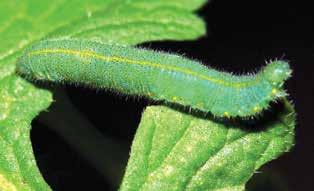
Monarch caterpillars eat only Milkweeds like this native Spider Milkweed. Since farmers now kill Milkweeds by spraying Round-upTM on their GMO corn and soybeans, Monarchs must depend on us, the home gardeners, to plant Milkweeds in our gardens.

beautiful silver-marked butterflies. Members of the Figwort Family, including Snapdragons, Angelonia, Toadflax and Plantain feed herds of Common Buckeye caterpillars. The plant will quickly recover from being munched and bloom even more vigorously after its haircut. Alyssum is in the Mustard family, just like Cabbage, Broccoli, and Kale, so you know which butterfly lays her eggs on all of these, the lovely Cabbage White! Considered an agricultural pest, this non-native was accidentally introduced from Europe in about 1860. It is now the most successful butterfly in North America, thanks to the many native mustards as well as our vegetable gardens.
Host Plants in the Lawn
Violets are viewed as weeds by many lawn-lovers, but they are a superb spreading native groundcover. The flowers and leaves are edible, not only for humans, but the Great Spangled Fritillary. Most adult butterflies only live a week or two, but this large orange and silver female butterfly glides in your garden from May to October before she spreads her eggs on the violets.
Summary: Buying Host Plants
You choose which butterflies nectar in your garden by which caterpillar host plants you supply. Rather than just hoping for luck, you can greatly increase the species and numbers of butterflies in your yard by deliberately planting the specific hosts. The Paola Master Gardener Plant Sale will have 40 different species of host plants and experienced butterfly gardeners to assist your shopping. Mark your calendar for April 27, 28, 29 and come see us at 913 South Pearl (the Extension Office parking lot) in Paola, KS.
LENORA LARSON Butterfly Maven

18 April 2023 | kcgmag.com
A Marais des Cygnes Master Gardener, Lenora is a member of the Idalia Butterfly Society and Kansas Native Plant Society. She gardens in the clay soil and cruel winds of Paola, KS. She may be contacted at lenora.longlips@gmail.com.
Green on green, Cabbage White caterpillars are hard to spot on a Broccoli leaf.
Human herb gardeners have “accidentally” greatly increased Black Swallowtail populations by planting Parsley, Dill and Fennel.
Photos by Lenora Larson.




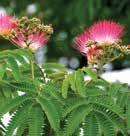


The Kansas City Gardener | April 2023 19 Your Gard en Source Your 816-483-0908 | missouriorganic.com Raised Beds ~ Backyard Gardens ~ Landscaping Top Soils • Garden Soil • Raised Bed Soil • Pulverized Top Soil • Custom Soil Mixes • Green Roof Soil Blends • Rain Garden Soil Blends Compost • NatureWiseTM • Green FrontierTM • Composted Forest Products • Composted Pine Fines Services • Sudden Gardens Consultation • Soil, Compost and Mulch Delivery and Installation Soil Amendments • Growing MOR Nutrient PackTM • Soil RestorationTM • JustCharTM Mulch • Premium I • Colored Mulches (red, brown & black) • Cedar • Hardwood Chips • Erosion Stabilization Introducing Our New Growing MOR Nutrient Pack! Nutritionally-dense premium plant food with biochar, locally-sourced trace minerals and mycorrhizae–everything your plants need to thrive all year long! You’ll find all of our quality products in bulk or bags at all of our locations. Also look for our bagged mulch at Sutherland’s Lumber. MISSED AN ISSUE? FIND BACK ISSUES AT KCGMAG.COM GRAB A CUP OF COFFEE, SIT BACK AND ENJOY OUR ARCHIVES KCGMAG.COM Pets and Plants NativeBouquets UsingBeneficialNematodes Do Butterflies Fall in Love? A Monthly Guide to Successful Gardening June 2013GARDENER The Kansas City Summer FloweringTrees Worth A Closer Look RARE ORGANIC TOMATO PLANT SALE $4.00 each 3 for $11.00 Starts May 12th! 9:00am for two weeks or until sold out Large orders or questions? 913-669-6267 Original location 2410 W. 78th STREET PRAIRIE VILLAGE, KS 66208
Growing up I remember African Violets thriving on my Grandmother’s kitchen windowsill. I like to think they were there because that is where she spent her time cooking for family and friends. Today, I have continued that tradition and grow my own African Violets in my kitchen. With floor-to-ceiling windows facing northeast and south, my room is bright and sunny.
I learned more about African Violets while attending meetings at the African Violet Club of Greater Kansas City. I was surrounded by fellow gardeners passionate about African Violets, and they were eager to share wisdom and experiences. Some have been members for over 35 years.
Kansas City is fortunate to have two different clubs, African Violet Club of Greater Kansas City and Sho-Me African Violet Club. Both clubs meet at Jacob L. Loose Park Garden Center; you can find their meeting time and additional in-
African Violets the classic indoor plant
formation on the African Violet Society of America (AVSA) website: africanvioletsocietyofamerica. org. I love African Violets so much that I am a member of both clubs. I enjoy attending meetings as it is a great place to socialize, obtain new information, and purchase other member’s plants.
African Violets are available at your local garden center, and often found in the grocery store floral department. African Violets are common houseplants because they flower reliably and are easy to grow. Plants have fuzzy leaves with pink, purple, or white flowers in various shades. Whether fringed and frosted, ruffled and rimmed, each is unique. They grow well in the low humidity and moderate temperature and good circulation of most home and office environments. With good care, plants can live and bloom for decades. Some growers have had their plant for over 50 years.
To keep your African Violet
HELEN GIESELMAN African Violet Gardener
healthy, it should be repotted every three months or so, into a pot that is a little larger than the plant, with the plant growth just above the soil line. Remove any dead or damaged foliage and remove the bottom three leaves each month to encourage new growth.
Several watering methods are described in detail on the AVSA website (Basics for Beginners). Many people use the water-wicking method by running a string from the top of the soil to the pot’s bottom hole to keep their plants healthy and watered. The pot is then placed on a reservoir of water. Be sure to change the water weekly. Take care to use room-temperature water and don’t get water on the leaves, as that can cause spots to form on the leaves.
Lighting is key. African Violets need bright light to bloom, NOT DIRECT SUN, like my kitchen with natural light described above. If your plant develops yellowing leaves, leggy stems and stunted
bloom growth, it probably needs more light.
Keep them warm. They perform best in temperatures between 65 and 80°F.
Be sure to sterilize tools after working on your plants.
African Violets and trailing African Violets, one that has more than one crown, are classified by size. Miniature (6 to 8 inches or less in diameter), semi-miniature (6 to 8 inches), standard (8 to 16 inches), and large (over 16 inches).

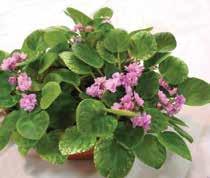


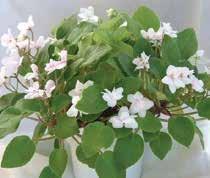
Sho-Me African Violet Club is holding their annual African Violet show which is open to the public on April 29 from 9:00 a.m. to 3:00 p.m. at Jacob L. Loose Park Garden Center, 51st and Wornall, Kansas City, MO. You will have the chance to not only purchase an African Violet, but also view the many beautiful plants on display being judged.
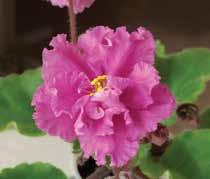


Join us at a show or in a meeting to learn even more about these classic indoor plants. Visitors are always welcome.
A lifelong gardener whose passion for African Violets began by her grandmother’s example. She has a deep appreciation for the intricate details, and continues to grow in her knowledge and skill by being a member of both Sho-Me African Violet Club and the African Violet Club of Greater Kansas City.

20 April 2023 | kcgmag.com
Candy Fountain
Raspberry Shout
Concord
Neonovaia Gvozdika
Falling Snow
Buckeye Cornucopia
Natural Rose Gem
Jolly Mischief
Photos courtesy of AVSA.
Planters
Mon-Sat 8am-5pm, Sun 9am-3pm

Time to plant your Garden!
Flowers & Vegetable Seed ~ Largest Selection in the Area

Grass Seeds • Fertilizers • Mulches • Bulbs • Bird Supplies • Pottery
Best Quality of “Locally Grown” Bird Seed!
Locally Grown • Beautiful Plants
AQUATIC PLANTS
MARGINALS, LILIES, AND LOTUS
POND AND LAKE
MANAGEMENT PRODUCTS
DIY POND SUPPLIES
PUMPS, LINER, AND MORE
AND KOI
PLEASE
CALL TO CONFIRM PLANT AND FISH AVAILABILITY

APRIL SHOWERS
• POND AND WATER FEATURE INSTALLATION
• SERVICE CALLS: LEAK DIAGNOSIS, LIGHTING, PUMP AND AERATION INSTALL
• LANDSCAPE LIGHTING: AMP LIFETIME FIXTURES AND TRANSFORMERS



• HARDSCAPES: PATIOS, WALLS, FIREPITS, DECKS, AND OUTDOOR LIVING



913-642-5034
halingsgreenhouse.com


LAKEVIEW NURSERY & STONE WE DELIVER! CALL TODAY! 816.525.1111 WWW.LAKEVIEWKC.COM 1820 NE COUNTY PARK RD, LEE’S SUMMIT

The Kansas City Gardener | April 2023 21
HUGE SELECTION All Locally Grown in our Small Greenhouse
SALE Save 10% if you shop on rainy days Free Delivery (Limited Area)
Open Mon.-Sat.
Sun. 12-5pm
St, Prairie Village, KS Open House Party April 27, 6-8pm April Planting Dates Plant Above-Ground Crops: 21, 22, 25-27 • Plant Root Crops: 5-9 Transplant: 25-27 • Plant Flowers: 21-22, 25, 26 • Control Plant Pests: 14, 15, 18, 19
9am-5pm,
6303 West 75th
Vegetable, Herb, Flower seeds and plants are here! Seed Co. • Since 1924 • Retail • Wholesale Lawn • Garden • Farm
513 Walnut, KCMO • 816-842-3651
GOLDFISH
12th
Retail Opens April
SAT:
FOLLOW US 4385 W. 247TH ST., LOUISBURG, KS
WWW.SWANSWATERGARDENS.COM
WED-FRI: 9AM TO 2PM
9AM TO 4PM 913-837-3510
66053
SERVICES
• CLEANOUT AND MAINTENANCE PROGRAMS
MDC partners with Martha Lafite Nature Sanctuary in Liberty for community conservation
Connecting people with nature is the goal of public-private partnerships
Martha Lafite Thompson had a passion for nature, and she wanted to share her land as a way for others to enjoy the natural world. After her death in 1975, the Martha Lafite Thompson Nature Sanctuary was created on her property in north Liberty to accomplish her goals. The Missouri Department of Conservation (MDC) is a longtime partner, part of the department’s partnership efforts statewide to provide and support for community conservation. This spring, visitors will find a special exhibit about Martha Lafite Thomp-
son in the education center, and outdoors, they will also see the helping hand MDC provided for wildlife habitat improvement via invasive bush honeysuckle removal.
The Nature Sanctuary is celebrating “The Legendary Lafite” with a special exhibit about her life that is open to the public. Photos, excerpts from Martha’s 1930s journal, and her life story are on display near the center’s indoor nature exhibits. Martha’s 53-acre property became the cornerstone for the nature sanctuary. Before her death, she had created hiking trails
on the property for visitors. Martha had partnered with the Burroughs Audubon Society of Kansas City for birding programs and wildlife habitat.
Shortly after Martha’s death, the private, non-profit corporation was created in 1976 to support the sanctuary. An adjacent 46-acre tract later came up for sale. MDC purchased the tract and then leased it to the Nature Sanctuary, doubling the sanctuary’s size and providing access to the scenic Rush Creek. That tract is titled as MDC’s Rush Creek Conservation Area, although it is managed by the sanctuary and is part of the overall trail system.
“There has been extensive bush honeysuckle removal this past summer thanks to an MDC community conservation grant for $8,400,” said Anne Nickel, the Nature Sanctuary’s board president. “Bush honeysuckle was removed from a fiveacre forested area near the pond. Volunteers are also continually removing honeysuckle from other savanna and forest habitats.”
The sanctuary’s nature center hosts educational programs and special events. Outdoors, four miles of hiking trails pass through restored prairie grassland, a glade, savanna, forest, a seasonal wetland, and the Rush Creek riparian habitat.
Kathleen Savaiano, MDC conservation educator, and Joe DeBold, MDC wildlife damage biologist, serve on the sanctuary’s board of directors.
On April 22, Earth Day, the sanctuary will hold an open house and family event with special activities entitled “Martha’s Earth Day Celebration.” Board members are working to grow an endowment, Nickel said, “so that the nature sanctuary will not just continue to exist but will be an active focal point for outdoor education and contemplation in our community.”
To learn more about MDC’s community conservation programs, visit https://short.mdc.mo.gov/4iG. For more information about Martha Lafite Thompson Nature Sanctuary, visit https://naturesanctuary.com.
MDC is a partner with the private, non-profit Martha Lafite Thompson Nature Sanctuary in Liberty. Rush Creek flows through an MDC-owned tract managed by the sanctuary, which is currently hosting an exhibit celebrating the life of Martha Lafite Thompson.



22 April 2023 | kcgmag.com
Photos by Bill Graham, Missouri Dept. of Conservation.
Spring Starts Here!
• Annual flowers
• Perennials
• Vegetable starters
• Shrubs & trees

• House plants
• Large selection of new pottery

• Full line of fertilizers



Earth Day Festival & Native Plant Sale

Make
Join

Presented by: 436 W. 85th St., Kansas City, MO • office 816-444-7661 waldogreenhousekc@gmail.com facebook.com/waldogreenhousekc
Tulip Time 2023 set for April 7-23
The event features tens of thousands of multi-colored tulips and flowering bulbs in Shawnee County Parks + Recreation’s three featured gardens – Ted Ensley Gardens at Lake Shawnee, Old Prairie Town/Ward-Meade Botanical Garden and Doran Rock Garden and surrounding areas in Gage Park. The event is named for its founder, Jerold Binkley who passed away in 2019.
There are two special events in addition to regular self-guided tours through the gardens. Tulips at Twilight features 90 larger than life lighted displays with thousands of tulips illuminated by candle light and lighted displays. The displays include 15foot tall illuminated tulips and larger-than-life illuminated flowers, illuminated mushrooms tall enough for patrons to walk beneath them, rivers of blue lights and floating lanterns in the Asian garden. Patrons may enjoy Old Prairie Town building tours on Friday and Saturday evenings. Tulips at Twilight is set for 7-10 p.m. April 7-23. Admission is a $5 per person with children five and under free.
Tulip Time Festival the Lake is set for April 15 at Ted Ensley

Gardens at Lake Shawnee. The event features 40,000 multicolored tulips of 30 to 40 varieties, daffodils and hyacinths in bloom along with food and craft vendors and a performance by the Topeka High Drumline. The festival runs from 10 a.m.-3 p.m. A $5 donation for the day gains guests entry to the gardens plus all of the entertainment and fun. SCP+R horticulturists each year plant special design in several tulips beds. Patrons are encouraged to try and spot them. Past designs have included a breast cancer cancer ribbon, a heart, a patchwork quilt tulip bed, an emoji and a Pokemon icon.
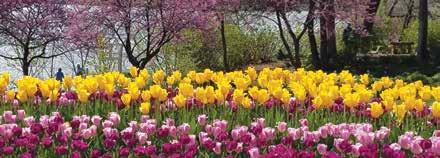


Tulip Time is an annual destination popular with everyone from area residents to out-ofstate visitors on bus tours. A $5 donation is suggested at Ted Ensley Gardens and Old Prairie Town/Ward-Meade Botanical Garden to help cover the cost of the event and enable Tulip Time to continue in future years. Guided tours for groups of 15 or more with advance reservations are available at Ted Ensley Gardens and Old Prairie Town/ Ward-Meade Botanical Garden (785) 251-6800.

The Kansas City Gardener | April 2023 23
us on Saturday, April 22, 2023, 10:00 AM-2:00 PM Metropolitan Community College–Longview Campus
SW Longview Rd, Lee’s Summit, MO
500
64081
us a tradition
Indoor Gardening: Edible Mushrooms
Venturing into the world of indoor mushroom growing can be intimidating at first. Spawn, substrate and sterilization aren’t the traditional jargon employed by tomato, spinach and cucumber growers. But don’t let a few new vocabulary words overwhelm you. In reality, mushrooms are relatively easy to produce at home without a significant investment of time, money or space. They don’t require expensive grow lights or fertilizers and they are relatively low maintenance.
The first, and perhaps most difficult step, is simply choosing which variety to grow. There are many types of mushrooms that can be grown indoors, including button, oyster, shiitake, and portobello. Each variety has its own environmental requirements, so it’s important to choose the right one for your space and skill level. For the novice mycologist, oyster mushrooms are generally a comfortable entry point. They’re easy to grow with minimal effort.
Once you have chosen your mushroom variety, it’s time to gather needed supplies. This is where the new lingo comes into play. You’ll need spawn (the “seeds” of the mushroom) for your chosen variety, substrate (the material for the mushrooms to grow on), a container with a lid, a spray bottle, drill with a small bit and alcohol (for sterilization). Typical substrates or primarily comprised of straw or sawdust from hardwoods such as maple, beech or ironwood. This is the medium where the mushroom’s mycelium will establish itself, gather moisture and feed on the carbon held within the material.
Plastic tubs or mushroom grow bags act as suitable containers. For our oyster mushroom example, I’d recommend starting with a plastic tub and hardwood sawdust substrate. Drill small holes all around the sides

and lid of the tub to allow for proper ventilation. Then, sterilize the container and lid with alcohol.
Before placing your substrate into the container, it will first need to be sterilized or pasteurized. This ensures that your mushrooms are pure and eliminates the risk of unwanted mold, fungi or bacteria taking hold. Mix your hardwood sawdust substrate with water in a large pot until it is moist but not soaked. Bring the mixture to a boil before letting it cool to room temperature. With the substrate prepared, pour it into your container and thoroughly mix in your spawn. A ratio of 5-10% spawn-to-substrate would be ideal for oyster mushrooms.
JASON MISPAGEL Indoor Gardener

Now, seal the container with the lid and let it incubate for several weeks in a warm, dark place (68F to 75F). During this time, the spawn will grow and colonize the substrate.
Initially, small white mycelium spots will form on the sawdust. Once they’ve covered the substrate in its entirety, it’s ready for fruiting (the period when edible mushrooms will form). Remove the lid from the container and move it to a location with indirect light (i.e., a windowsill or spare room with a light on) and high humidity. Mushrooms don’t use light to photosynthesize like plants do, so their needs are very minimal. Instead, light is the trigger for them to begin fruiting.
Mist the substrate with water several times a day to keep it moist and, within a few days, you should begin to see mushrooms growing out of the substrate. Once the oyster caps are open but have not become flat, carefully pick them from the substrate by twisting at their base. They’re ready to eat! Continue misting the substrate, even after harvesting, to encourage new mushroom growth.
Hopefully your first fruitful harvest will provide the inspiration to dig a little deeper into mycology and all the various substrate combinations, mushroom types and growing methodologies. Happy growing!
24 April 2023 | kcgmag.com
Jason Mispagel is the co-owner and operator of Year-Round Garden, a grower’s supply center serving both home and commercial customers since 2016. To contact Jason, call 816-216-6917 or jason@year-roundgarden.com.






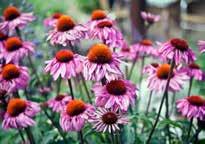
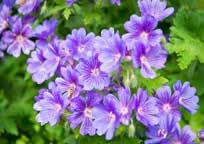


The Kansas City Gardener | April 2023 25 Check our website and Facebook for more information. THE METRO’S ONLY FULLY STOCKED, DEDICATED POND STORE! With the most diverse selection of equipment and livestock, we have products for all levels of pond hobbyists and the knowledge and experience to help you create and maintain your pond paradise! Come see us first for your pond liner needs. Great prices for both hobbyists and installers We carry a large selection of domestic and imported Koi from the best suppliers in the world! Scheduling pond cleanings and spring openings now. We have the friendliest, knowledgeable staff and serve the entire Kansas City metro! Welcome Lawrence Hobbyists! 816-842-5012 • pondskc.com 1557 Swift Ave, KCMO 2023 Plant Sale Wyandotte County Extension Master Gardener Tomatoes, Peppers, Herbs, Berries, Hanging Baskets, Annual Flowers, and Perennial Flowers Available! Friday, April 28 9 a m to 5 p m Saturday, April 29 9 a.m. to 2 p.m. Dates Location: Wyandotte County Research and Extension Office: 1200 N 79th st Kansas City, Ks 66112 K-State Research and Extens on s comm tted o provid ng equal opportun ty for part c pat on in al programs serv ces and act v t es Program nfo ma ion may be ava ab e n languages other than Eng sh Reasonab e accommodat ons or pe sons w th d sab t es nc ud ng a ternat ve means or commun cat on e g Bra e arge pr nt aud o tape and Amer can S gn Language) may be equested by contact ng he t Ly L gh y t k p t h t f th Ap 9 2023 t (913-299-9300 loughar@ksu edu Requests rece ved af er th s date w be honored when t is eas b e to do so Language access serv ces such as in erpretat on o trans at on of v ta n ormat on w l be p ov ded ree of cha ge to m ted Eng sh prof c ent ind v dua s upon equest 913-299-9300 wyandotte.ksu.edu
Upcoming Garden Events
Raytown Garden Club
Tues, Apr 4, 10a; at Connection Point Church, 10500 E 350 Hwy, Raytown, MO 64138. Program will be “Living With the Amazing Bees in your Garden” presented by Tom Schroeder, Missouri Master Naturalist and KC Wildlands volunteer. Guests are always welcome. For more information please check out our Facebook page: https://www. facebook.com/RaytownGardenClub
The Garden Club of Shawnee
Wed, Apr 5, 7p—Please note the date and topic change!—at Shawnee Town 1927 Town Hall, 11600 Johnson Dr, Shawnee, KS. Nancy Chapman, K-State Extension Master Gardener, will talk about Growing Vegetables Successfully in Kansas. As always, we will serve drinks and snacks, and nifty door prizes will be given away. Visitors are welcome! Please visit our web site gardenclubofshawnee.org and our Facebook page for more information.
Plant This, Not That!
Wed, Apr 5, 6:30-7:30p; at Basehor Community Library, 1400, 158th St, Basehor, KS 66007. You don’t have to stay with the same old plants your neighbors have. Many different choices are available for shrubs, trees, perennials and annuals. Be brave and change it up!
Mikey Stafford, a Leavenworth County Master Gardener, will be bringing new ideas and lots of suggestions to help do you just that. The meeting is free and open to the public. For more information contact the Leavenworth County Extension office at 913-364-5700.
Leavenworth County Master Gardeners
Wed, Apr 12, 11a; at Riverfront Community Center, 123 Esplanade St, Leavenworth, KS 66048. Lenora Larson, a Marais des Cygnes Extension Master Gardener and member of the Kansas Native Plant Society, will present “Creatures of the Night.” Many remarkable animals live in darkness, but are attracted to lights. Learn how
to attract and identify likely visitors; such as beautiful moths, nocturnal beetles and interesting flies. The meeting is free. Visitors are welcome. For more information contact the Leavenworth County Extension office at 913-364-5700.
Kansas City Cactus and Succulent Society
Sun, Apr 16, 1:30p; at the Trailside Center, 9901 Holmes Rd, Kansas City, MO. A Webinar will tie into our photo contest: Irwin Lightstone: Succulessense: Capturing the Plant’s Character in Your Photography. The Photo Contest - A Photo Contest in two parts! Based on Irwin’s ideas presented in the webinar video. Plus, a special Raffle Drawing at this meeting! Tickets $1 or 6 tickets for $5. Join us at the meeting to discover items to be raffled off.
Bonner Springs Garden Club
Tues, Apr 18. We’ll be going on a tour of one of our member’s gardens at 10am. Following our tour we’ll be going to a local restaurant for lunch and business meeting. For further information about our club or our upcoming programs, please contact bonnerspringsgardenclub@ gmail.com. Anyone interested in gardening is invited to join in our fun at our next meeting.
Olathe Garden & Civic Club
Meeting & Quiz Game with Prizes
Tues, Apr 18, 1-2:30p; at Grace Church, 11485 S Ridgeview Rd, Olathe, KS 66061. *Free to attend and open to the public, Club membership not required* Please join us for our monthly club meeting and a “Name That Flower” quiz game with prizes!
Growing Vegetables in Small Spaces: Pots and Plots
Thurs, Apr 20, 7p; at Leavenworth Public Library, 417 Spruce St, Leavenworth, KS 66048. Do you want to grow vegetables, but don’t think you have the space for a vegetable garden? This presentation is just for you! You will learn how easy it is to grow your favorite vegetables in very small
spaces on your deck or patio; in a narrow space alongside your home or mixed in amongst your flowers. The presenter is Joseph O’Neill, a Leavenworth County Master Gardener. The meeting is free and open to the public. For more information contact the Leavenworth County Extension office at 913-364-5700.
Leawood Garden Club
Tues, Apr 25, 12-1p; Cure of Ars Catholic Church, 9401 Mission Rd, Leawood, KS 66203. “Gardening

As We Age” by: Kevin Nelson a Douglas County Master Gardener. Kevin Nelson has had an interest in gardening that began at the age of six, working in his father’s garden as a “mulcher.” Kevin began gardening 50 years ago and has completed many landscaping projects personally and professionally as an assistant superintendent on a golf course in college. Now retired, he became a Master Gardener in 2017. He has been very active within Douglas County EMGs serving 2 years as President, the Coordinator for the largest demonstration garden at the fairground, the handyman for Waystation #1, and he is currently the PR Coordinator serving on the board. During his five years, he has been awarded Outstanding New Master Gardener, and most recently, the 2021 Outstanding Lead on the larger stage, Kevin won the 1st prize in the Search for Excellence Awards at the 2019 Kansas Master Gardener conferences for his idea of QR code next generation plant labels. As one who has been gardening for over half a century, Kevin has some valuable information on “Gardening as We Age.”
Annual OPA Spring Plant Sale
Apr 27, 28, 29 & 30; at Overland Park Arboretum. Support the Arboretum while shopping the best selection of locally grown plant varieties. Chat with one of our gardening experts and enjoy a special curation of pollinator-friendly flowers! Our plant sale list will be available for your viewing pleasure in early April on our website opabg.org and on our social media platforms. Friends of the Arbore-
tum members get to preview the sale a day early on Thurs, Apr 27 from 2-8pm. Sale will be open to the public Fri, Apr 28 to Sun, Apr 30 from 9am to 5pm. We look forward to seeing you in the gardens and cheers to spring!
Thyme for Kids Plant Sale
Apr 28 & 29, 9a-5p both days; Cornerstones of Care – Ozanam Campus, 421 E 137th St, Kansas City MO. Stock up on plants for your home and garden, while helping children grow and thrive! Cornerstones of Care’s Thyme for Kids Plant Sale is so much more than a plant sale, and proceeds funnel right back into our horticulture program. Your purchases help fund seeds, supplies, stipends, and more. Questions? Visit cornerstonesofcare.org/ plantsale or email Stefanie.caravella@cornerstonesofcare.org.
Plant & Garden Exchange
Apr 28 & 29; at Tonganoxie Public Library, 217 E 4th St, Tonganoxie, KS 66086. This is an excellent chance to give away plants, seeds, garden items, etc., you no longer need or want and to maybe find something new to inspire you. Anything goes as long as it’s plant or garden related! Everything is FREE! Everything will be arranged in the Community Room for viewing. Any questions, email Kim at kimd@tonganoxielibrary.org. Drop off day is Fri, Apr 28 from 2-7p. Sat, Apr 29, 10-11a is just for those people who donated items. After 11a is for anyone at all, whether they donated or not.
Raytown Garden Club Plant Sale
Sat, Apr 29; club will celebrate Earth Day at Cave Spring Interpretive Center, 8701 E Gregory Blvd. The sale opens promptly at 8a and will run until 12p or until all plants are sold. We will have a sale of properly named plants and members will be available to answer questions from the public.
Spring Native Plant Sale
Sat, Apr 29, 9a-2p; at Shawnee Indian Mission East Building Parking (continued on page 28)
26 April 2023 | kcgmag.com




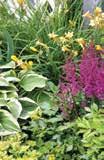







The Kansas City Gardener | April 2023 27 April 27, 28, & 29 2023 Thursday 9:00 - 5:00 Friday 9:00 - 6:00 Saturday 9:00 - 1:00 Opens Daily at 9:00 am Paola Plant Sale 913 N. Pearl, Paola, KS, 66071 The sale will be held in the parking lot of the Extension Offices located at 913 N. Pearl, (Old K1C Road) Paola, KS Pesticide-free, Locally Grown! More Butterfly Host Plants than ever! Native Plants Pollinator Plants Herbs Annuals Perennials Veggies Succulents Hanging Baskets Trees Hypertufa Gifts! Master Gardener Marais de Cygnes District Cash, Credit Cards & Checks Accepted Sponsored by: 7130 Troost, Kansas City, Mo. www.soilservice.com 816-444-3403
Installation and Maintenance Services From trees and shrubs to perennials, mulch and stone, expert Landscape Designers are ready to help with your next project! Call today for an At-Home Consultation. Koi Pond and Water Feature Designs Wendy Hix • 913.481.5416 Tate Foster • 913.406.6804 www.hixandsonaquatics.com New Installations, Remodels Upgrades, Repairs and Maintenance Services
Landscape Design,
Upcoming Garden Events
Lot, 3403 W 53rd St, Fairway, KS 66205. Shop in person for native plants at the beautiful Mission. PreShop and Pre-order through April 25, from Missouri Wildflowers Nursery. Their online catalog will inform your selections. Please note/ mention that you are ordering for the Shawnee Indian Mission Sale when you order. Your purchase benefits the Mission. A contribution to the Mission will be based on sales. Thank you! And, as a Special BONUS, see first-hand a selection of NEW, unique Artisan items from the Mission’s Three Springs Market (normally online only) collection in front of the Mission’s West Building (parking available in front of West Building or just across 53rd St).
Northwest Missouri Master
Gardeners’ Plant Sale
May 5 & 6, 8a-3p both days; at the University of Missouri Extension office, 4125 Mitchell Ave, St Joseph, MO. Unique varieties of tomatoes, peppers, eggplants and herbs are featured. Master Gardeners on hand both days to answer questions. Cash/check only please. 816-279-1691 for questions.
CMMG Plant Sale
Fri, May 5, 9a-6p and Sat, May 6, 8a-noon; at CMMG Greenhouses, 801 Sandstone Rd, Jefferson City, MO. Central Missouri Master Gardeners plant sale: tomatoes, peppers, herbs, perennials, hanging baskets and more. Cash and credit accepted.
Shawnee County Extension
Master Gardener Plant Sale
Sat, May 6, 9a-noon; at Agriculture Hall, 1 Expo Dr, Topeka, KS. All plants Master Gardener grown. Plants for sale include impatiens, petunias, coleus, zinnias, vinca, red salvia, pollinator plants, native plants, tomatoes, peppers, herbs, perennials.
Thinking Outside the Arbor: Clematis Varieties, Uses and Care
Thurs, May 11, 11:30a. Presented by Linda Beutler, via Zoom. Register here: https://ksu.zoom.
us/meeting/register/tJYsce2qrjsoE903aEkXyvz0Ao8ZBS4XlUcb
The international clematis community has been rewriting the script on clematis cultivation. Previously untried species are being used in hybridizing, garden designers are using clematis in new ways, and long-outmoded pruning groups have been scrapped in favor of an easier, common-sense approach to getting the most out of your clematis. Let’s be honest: judging any plant by when or how you prune it is a lousy way to assign gardenworthiness. Join clematis aficionado and “popularizer” Linda Beutler for all the latest clematis advice. If we bust a few myths along the way, so much the better. Linda Beutler is a heedless gardener who grows a great variety of plants on a simple, flat 50’ x 100’ city lot in Portland, Oregon. Her first love was growing flowers and foliage for cutting. That focus changed when Linda purchased her first clematis as a misnamed plant. Linda has been the curator of the Rogerson Clematis Collection at Luscher Farm outside Lake Oswego, Oregon since July 2007. She has been an instructor of horticulture at Clackamas Community College since 1996. Linda lectures internationally on numerous gardening topics, and travels widely to visit gardens and study clematis in the wild. She is the author of Gardening with Clematis (Timber Press, 2004), Garden to Vase (Timber Press, 2007) and Plant Lovers Guide to Clematis (Timber Press 2016). Linda has been President of the International Clematis Society (2013-18) and continues to serve on the governing council. In 2017 she chaired the Clematis Cultivation & Classification Working Group, tasked with redefining clematis pruning advice and restating how the various clematis are classified based on flower type and bloom time.
Kansas City Rose Society’s Rose Photography Workshop
Sat, May 13, 9:30-11:30a; at Loose Park Garden Center, cost $5.00, learn how to photograph a prize winning rose. Please reserve your
place online at kansascityrosesociety.org or contact JJ Jensen at jusJustjjnKC@gmail.com.
Miami County Spring Farm Tour
May 13-14. This is a free event and sites will be open from 10a to 4p daily. For more information about the farm tour or to receive a map of the sites please call 913-2944045. The tour’s website, www.MiCoFarmTour.com, features a map of the sites and information about their location.
Northwest Missouri Master Gardeners Garden Tour
Sat, May 20, 10a-4p. Six local gardens are diverse in their scope and educational topics include lasagne gardening, creative mulching, iris cultivars, organic and low maintenance ornamentals, rain barrels, and home composting. We will feature herb, finch, pollinator and vegetable gardens as well. Tickets are $10 and can be purchased from any of the NWMMG members, the MU Extension office at 4125 Mitchell Ave, St Joseph, MO, or at any of the six locations on the day of the tour. Locations may be found on the Northwest Missouri Master Gardeners’ Facebook page.
Train Garden Tour
Sat, Jun 3, 10a-4p and Sun, Jun 4, Noon-4p. Adults and kids are invited to tour the unique train gardens at homes in the greater Kansas City area. They are like a miniature world with model trains running through garden landscaping, with small houses and buildings, trees, plants, water features, bridges and tunnels. Hosted by the MO-KAN Garden Railroaders, the admission cost for this self-guided tour to all gardens is $10 per car. Fifty percent of the proceeds go to Harvesters Food Network. For tickets and tour guide, go to www.mokangardenrailroaders.org.
Kansas City Rose Show
Sat, Jun 3; at Loose Park Garden Center, 51st and Wornall, Kansas City, MO. Free and open to all rose gardeners with assistance provided
for first-time exhibitors. Classes for live blooms and rose photographs. Entries accepted from 8-11a. Visit https:www.kansascityrosesociety. org for the show handbook with class lists and show rules. Also find links to tips on how to grow and show prize-winning roses.
Kansas City Rose Day Sun, Jun 4, 1-5p; at Laura Conyers Smith Rose Garden in Loose Park. View the results of the Rose Show in the Garden Center with hundreds of blue-ribbon winners and gleaming trophies. In the garden, enjoy family activities, live entertainment, and an afternoon of beauty in this world-renowned rose garden. Free to everyone. Visit https:// www.kansascityrosesociety.org for further information.
Garden Sampler Tour and Raffle Sat, Jun 10, sponsored by the Garden Club of Shawnee. Our Club sponsors a biennial tour of the private gardens of Shawnee and surrounding cities. Proceeds from the tour and raffle are used to fund a Grant Program for local schools, churches, and not-for-profit organizations to beautify and educate about gardening. Tour tickets will be available to purchase in advance via Eventbrite at www.thegardenclubofshawnee.org and at area business starting mid-April. Also plan to purchase raffle tickets (cash only) for chances to win great prizes donated by community merchants and generous citizens. COME JOIN US! Enjoy a day filled with the beauty our featured gardens offer on June 10th, 9 am to 5 pm (rain or shine).
Promote plant sales, club meetings, classes, and other gardening events for FREE!

Send details to: elizabeth@kcgmag.com.
Deadline for publishing in the May issue is April 5.
28 April 2023
| kcgmag.com
(continued from page 26)
The Rush is on!
Don’t wait any longer to get your equipment in for a Spring tune up.
Tune ups include changing the oil and filter, replace spark plug, air filter, and sharpening blades.
Authorized service center for most major manufacturers.
Commercial Trimmers, Backpack Blowers and zero turns!




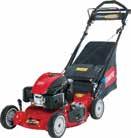
All equipment is assembled and ready to use when you buy it. Nothing goes out of here in a box!
We carry feed, pet supplies, and lawn and garden supplies!




Northland Feed
Serving the Northland for 45 years
The Kansas City Gardener | April 2023 29 One free, easy call gets your utility lines marked AND helps protect you from injury and expense. Safe Digging Is No Accident: “Always Call Before You Dig in Kansas” Call 811, 1-800-DIG-SAFE, (800-344-7233) or visit us at www.kansas811.com.
N. Brighton, KCMO • www.mowerpartskc.com 816-452-8393 • Mon.-Fri. 9am-6pm • Sat. 9am-1pm Closed for lunch Mon.-Fri. 12:45-1:30pm
4807
GARDEN CALENDAR
April list of what to do in the garden.
LAWN
• Apply preemergent crabgrass control by April 15 for best results.
• Remove winter debris, leaves, and twigs from the lawn before the first mowing.
• Check mowers before starting. Change the oil, clean the air filter, and sharpen the blade.
• Set mower one notch lower than usual to remove brown leaf tips, do not scalp.
• Mow bluegrass and tall fescue at 3 inches, removing no more than 1/3 of the leaf blade.
• Let the grass clippings fall unless piling up on the turf.
• Spot seed to fill in bare areas by midmonth.
• Avoid the temptation to mow or fertilize zoysia lawns until May.
• Spot treat for broadleaf weed control.
• Do not water unless experiencing a severe drought or applying chemicals.
VEGETABLES
• Prepare soil for spring planting; avoid working wet soil.
• Soil test to determine fertility needs.
• Fertilize soil and add organic matter for improvements.
• In early April, plant salad crops such as carrots, beets, onions, lettuce, and spinach.
• Thin salad crops to add space for development.
• Add perennial vegetables to the garden, like asparagus and rhubarb.
• Begin asparagus harvest and continue until spear size decreases.
• Plant cabbage, broccoli, and cauliflower very early in the month for the best yield.
• Plant beans, corn, and other crops in late April.
• Control weed growth in the garden with light cultivation and mulch.
• Turn compost pile to increase breakdown.
FRUITS
• Begin fruit tree spray programs.
• Prune fruit trees if the task is not already complete.
• Plant new fruit trees.
• Plant small fruits such as strawberries, raspberries, and blackberries.
• Prune raspberries and blackberries.
• Prune grapevines.
• Remove winter mulch from the strawberry bed.
• Avoid using insecticides during bloom time on fruits to protect honeybees.
• Fertilize fruit planting.
TREES AND SHRUBS
• Plant new trees and shrubs.
• Fertilize young plants for added growth.
• Apply mulch around the base of trees and shrubs.
• Water newly planted trees and shrubs as needed.
• Prune trees and shrubs, except those that bloom early in the spring.
• Remove suckers and other shoots from the
trunks of trees.
• Mulch around young trees as grass removal can double the growth rate.
FLOWERS
• Prepare soil for planting. Add organic matter and fertilizer.
• Remove winter mulch from perennial gardens.
• Cut back last season’s growth on perennials.
• Fertilize spring flowering bulbs before bloom for best results.

• Remove seed heads from spring flowering bulbs.
• Leave foliage on bulbs until it dies back naturally.
• Plant or divide perennials.
• Plant new roses.
• Fertilize and prune roses.
• Transplant or seed cool-season annuals such as pansies or snapdragons.
HOUSEPLANTS
• Repot overgrown plants by increasing pot size by 1 inch.
• Clean leaves with warm water and a soft cloth to remove dust and improve light.
• Prune plants to shape and promote new growth.
• Begin fertilization for summer growth.
• Remove spent leaves and flowers.
• Start new plants by divisions or cuttings.
• Resist the temptation to move plants outdoors until nighttime temps remain above 60 degrees.
Johnson County K-State Research and Extension recommends environmentally-friendly gardening practices. This starts by identifying and monitoring problems. Cultural practices and controls are the best approach for a healthy garden. If needed, use physical, biological or chemical controls. Always consider the least toxic approach first. Dennis Patton is the horticulture agent for Johnson County K-State Research and Extension. For free information fact sheets, visit www.johnson.ksu.edu, or call the Extension office at 913-715-7000.

30 April 2023 | kcgmag.com
Spring Plant Sale at the Overland Park Arboretum






Spring always brings such hope and renewal. We are excited for the green, warmer temperatures and new plants to grow and nurture. We are experiencing additional excitement and anticipation here at the Overland Park Arboretum and Botanical Gardens as we open a new visitors center later this summer. There will be new opportunities to see new gardens in addition to our current gardens.
Each year we aim to bring you the best of what we utilize here in the gardens, new varieties and reliable favorites at the Annual Spring Plant Sale in April. One of my favorite early perennials is the Hellebore or Lenten Rose. These are great for the part shade or shade areas in your landscape. They deliver blooms in early spring in a variety of colors and forms. Black Diamond is a rich, burgundy, black flower that looks magnificent with Bluebells (Mertensia), Daffodils (Narcissus) and other spring lovelies. Hellebore French Kiss is a cool pink with flecks of darker pink.
If pollinators are a focus for your garden, we have a multitude of options. We are offering seven varieties of perennial and annual Asclepias, including everyone’s favorite Gomphocarpus physocarpus, aka Balloon Milkweed or Hairy Balls Milkweed. We will have wonderful nectar plants like Salvia, Butterfly Bush (Buddleia), Coneflowers (Echinacea), Lantana and Blazing Star (Liatris). There are options in every size and color you can imagine. If you are looking for a tree, we are offering the smaller sized Temple of Bloom SevenSon Flower (Heptacodium). It is adored by pollinators in the late summer and early fall. Only getting 6-10 feet tall, it is a great small tree.
For those of you who are
looking for shady options, we are featuring Azaleas from the Perfecto Mundo series. These Azaleas bloom in the spring and also give a repeat show in the fall. They were developed by an NC State University professor, so they have better heat tolerance and hardiness. There are also Hydrangeas to consider from Panicle to Oakleaf, several species of ferns and some newer varieties of Hostas. Coleus can add additional color and texture. If you have not tried a Coleus in your summer landscape you must come shop our nine different selections. Glimmer impatiens are an annual I would encourage you to try. They are bred to be resistant to Impatiens Downy Mildew, so this classic annual can once again be enjoyed in your gardens.
Texture is a must for all landscapes and containers. Check out our selection of cute evergreens. Anna’s Magic Ball & Tater Tot Arborvitae (Thuja) are perfect for small gardens. Grasses like Standing Ovation Little Bluestem (Schizachyrium) and Ruby Grass (Melinis ‘Savannah’) will glow in your full sun areas. Herbs can even fill that box, with the different varieties of basil, cilantro, parsley, thyme and rosemary we are offering. You get great things to cook with and they are pretty to look at!
There are so many wonderful options for you to peruse and consider. Our plant sale list will be available for your viewing pleasure in early April on our website opabg.org and on our social media platforms. Friends of the Arboretum members get to preview the sale a day early on Thursday, April 27 from 2-8pm. Sale will be open to the public Friday April 28 to Sunday April 30 from 9am to 5pm. We look forward to seeing you in the gardens and cheers to spring!

The Kansas City Gardener | April 2023 31 Name: Address: City, State, Zip: Phone: E-mail: Where did you pick up The Kansas City Gardener? Please enclose your check payable to The Kansas City Gardener and mail with this form to: P.O. Box 8725, Prairie Village, KS 66208 The Kansas City Gardener is published monthly Jan. through Dec. For convenient mail delivery, complete the form below and send with your check for $35.00. You will receive a oneyear subscription. SUBSCRIBE TODAY To see a full list of openings, visit suburbanlg.com/employment/ Now Hiring Plant Sales, Cashiers, and General Labor 3 Easy Ways to Apply Now Email resume By Text suburban@suburbanlg.com 13600 Wyandotte, KC MO In Person Questions? Call Human Resources 816-941-4700




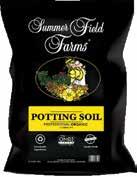
32 April 2023 | kcgmag.com Sale Up to 50% Off select varieties Spring Tree & Shrub New trees and shrubs arrive daily from our very own local farms! Take home the blooms of April and watch the season unfold in your garden. Stop in to any of our locations for a great selection of annuals and perennials. Bloom Value in a Bag • All six of our Summer Field Farms soil products are locally sourced and produced by us. • Premium Quality at the best possible price. • Available at all three Suburban Locations & Online
Field Farms Enjoy a visit to one of our nurseries or browse online. Suburbanlg.com/SpringNurserySale pictured: Royal Raindrops Crab Apple, $149.99-$279.99 (reg. $189.99-$379.99) Combo Pots starting at $21.99 suburbanlg.com K-7 & Prairie Star Pkwy (913) 897-5100 135th & Wornall (816) 942-2921 105th & Roe (913) 649-8700
the
Summer
Let
Good Things



















































































































































































































